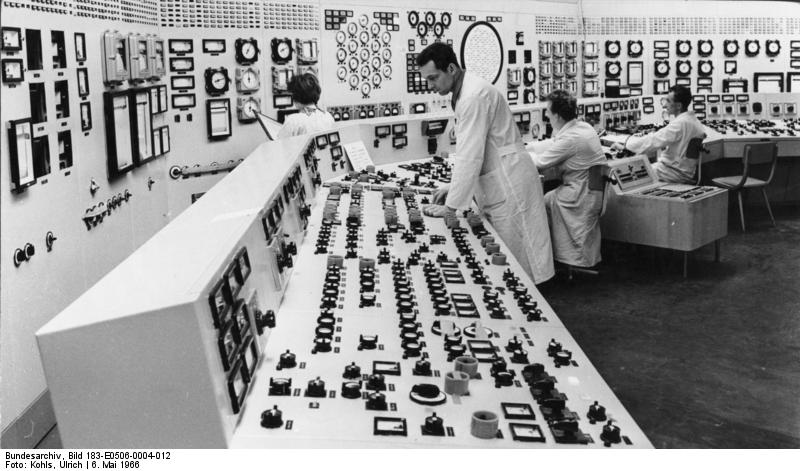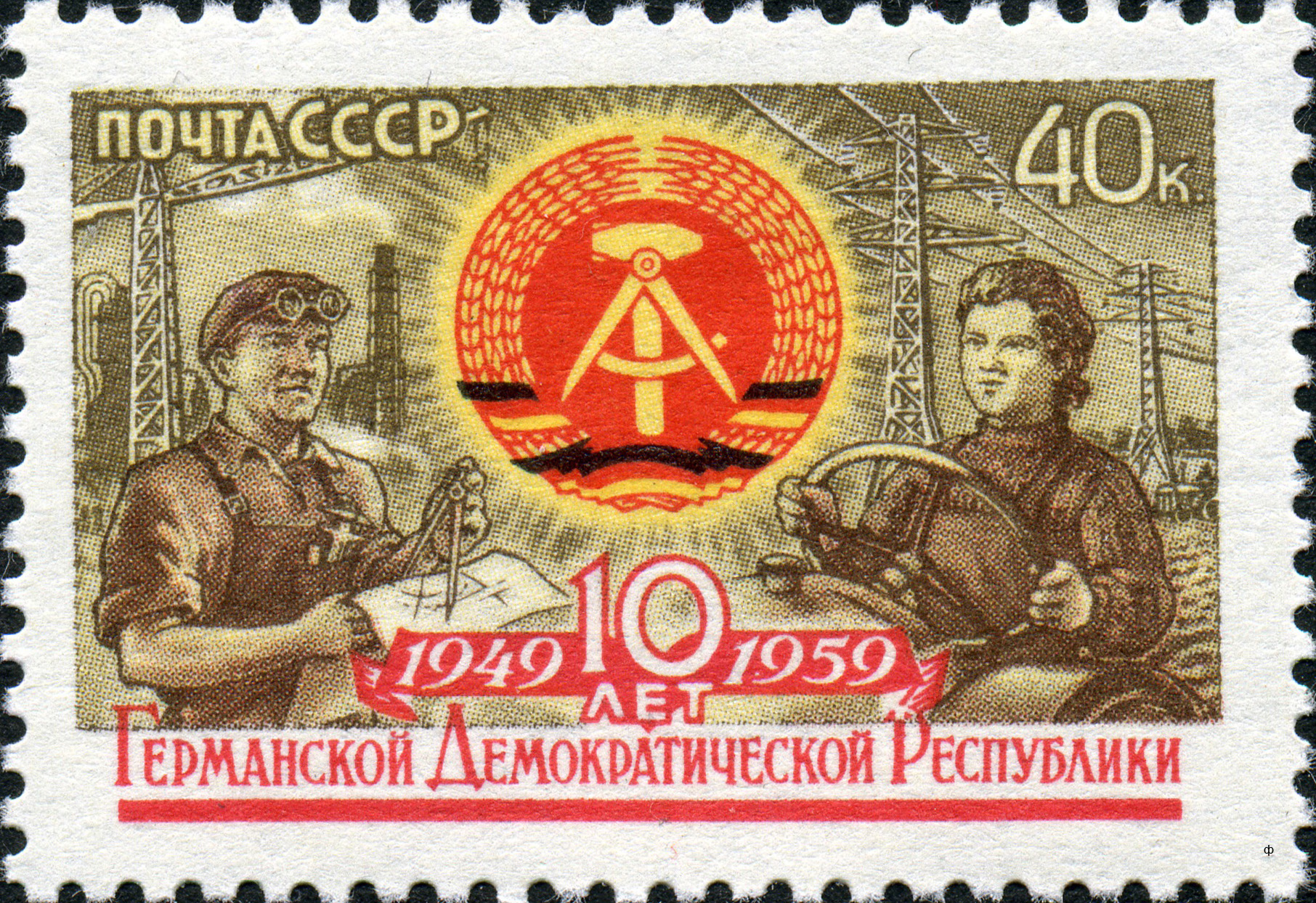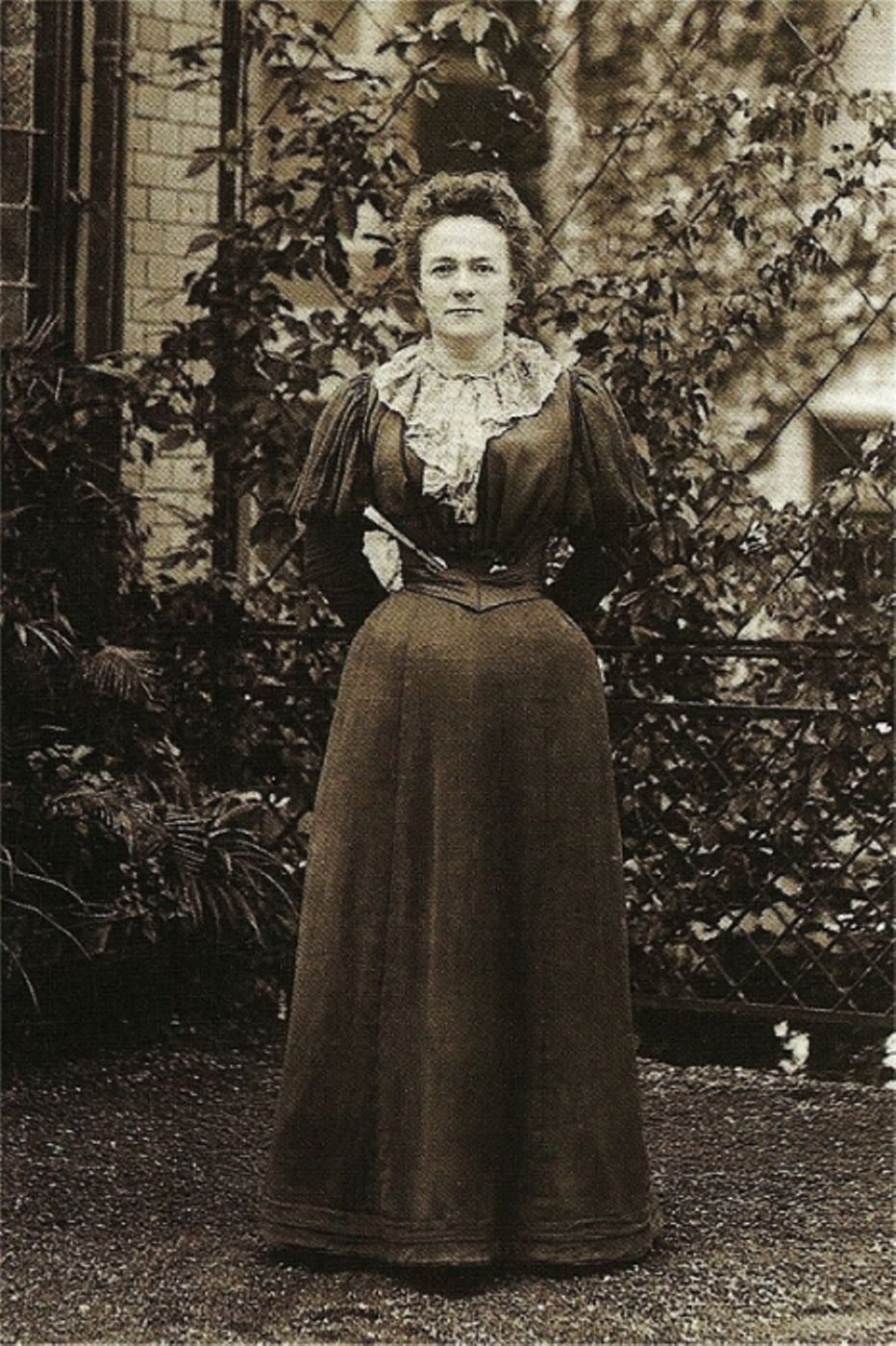|
Rheinsberg Nuclear Power Plant
Rheinsberg Nuclear Power Station was the second nuclear reactor in East Germany after the Rossendorf Research Reactor, and the first nuclear power reactor in East Germany. It was built close to the city of Rheinsberg on the Stechlinsee. The power station was one of the first generation of demonstration power reactors. Start-up The project commenced in 1956, and construction began January 1, 1960. First criticality followed on March 11, 1966 (the reactor was not pressurised at that time however). Full start-up was on May 9, and commercial power production began on October 11, 1966. Achievement The single pressurized water reactor was of Soviet design – type VVER-210. Gross power of the station was 70 MWe, but 8 MWe was required to run plant systems, so net output to the grid was 62 MWe. Gross power output was subsequently raised to 75 MWe and then 80 MWe as operating experience increased. Cooling water was taken from the Nehmitzsee and by a special discharge channel was di ... [...More Info...] [...Related Items...] OR: [Wikipedia] [Google] [Baidu] |
Germany
Germany,, officially the Federal Republic of Germany, is a country in Central Europe. It is the second most populous country in Europe after Russia, and the most populous member state of the European Union. Germany is situated between the Baltic and North seas to the north, and the Alps to the south; it covers an area of , with a population of almost 84 million within its 16 constituent states. Germany borders Denmark to the north, Poland and the Czech Republic to the east, Austria and Switzerland to the south, and France, Luxembourg, Belgium, and the Netherlands to the west. The nation's capital and most populous city is Berlin and its financial centre is Frankfurt; the largest urban area is the Ruhr. Various Germanic tribes have inhabited the northern parts of modern Germany since classical antiquity. A region named Germania was documented before AD 100. In 962, the Kingdom of Germany formed the bulk of the Holy Roman Empire. During the 16th ce ... [...More Info...] [...Related Items...] OR: [Wikipedia] [Google] [Baidu] |
Deutschlandradio Kultur
Deutschlandfunk Kultur (; abbreviated to ''DLF Kultur'' or ''DKultur'') is a culture-oriented radio station and part of Deutschlandradio, a set of national radio stations in Germany. Initially named ''DeutschlandRadio Berlin'', the station was renamed ''Deutschlandradio Kultur'' on 1 April 2005. The present name was adopted on 1 May 2017. The station's studios are in what was the RIAS building at Hans-Rosenthal-Platz in Schöneberg, Berlin. History Deutschlandfunk Kultur's roots go back to the first Deutschlandsender, set up in 1926. After World War II, ''Deutschlandsender'' became the main national radio station of the German Democratic Republic (GDR), with programming aimed at all of Germany. In the 1970s it was merged with the main Berlin station ''Berliner Welle'' and renamed ''Stimme der DDR'' - "Voice of the GDR". It lasted until February 1990 when it again became ''Deutschlandsender'', and in May 1990 it merged with Radio DDR 2. The merged entity was named ''Deutschland ... [...More Info...] [...Related Items...] OR: [Wikipedia] [Google] [Baidu] |
East Germany–Soviet Union Relations
Throughout their existence East Germany and the Soviet Union maintained close diplomatic relations. The Soviet Union was the chief economic and political sponsor of East Germany. History In 1964, Anastas Mikoyan's 10–12 March trip to East Berlin, ostensibly to celebrate the 70th birthday of inactive and ailing Premier Otto Grotewohl, was particularly curious in light of the fact- that no other bloc dignitaries of Mikoyan's rank attended. Mikoyan's appearance seemed to represent a Soviet effort to assuage East German fears on certain economic and military points of disagreement. In 1963 the 13 June Soviet-GDR joint communique recorded Ulbricht's praise for Khrushchev's policy of "mutual example" in a manner that could be read as giving approval in principal to further Soviet efforts in that vein, including a reduction in the Soviet forces in East Germany. Brezhnev era On the day Khrushchev left for his vacation, East German Premier Willi Stoph made a sudden visit to Moscow ... [...More Info...] [...Related Items...] OR: [Wikipedia] [Google] [Baidu] |
Former Nuclear Power Stations In Germany
A former is an object, such as a template, gauge or cutting die, which is used to form something such as a boat's hull. Typically, a former gives shape to a structure that may have complex curvature. A former may become an integral part of the finished structure, as in an aircraft fuselage, or it may be removable, being using in the construction process and then discarded or re-used. Aircraft formers Formers are used in the construction of aircraft fuselage, of which a typical fuselage has a series from the nose to the empennage, typically perpendicular to the longitudinal axis of the aircraft. The primary purpose of formers is to establish the shape of the fuselage and reduce the column length of stringers to prevent instability. Formers are typically attached to longerons, which support the skin of the aircraft. The "former-and-longeron" technique (also called stations and stringers) was adopted from boat construction, and was typical of light aircraft built until the ad ... [...More Info...] [...Related Items...] OR: [Wikipedia] [Google] [Baidu] |
Greifswald Nuclear Power Plant
Greifswald nuclear power station (German: ''Kernkraftwerk Greifswald'', KKW Greifswald), also known as Lubmin nuclear power station, was the largest nuclear power station in East Germany before closure shortly after the German reunification. The plants were of the VVER-440/V-230 type, which was the second generation of Soviet-designed plants. The plant is in Lubmin near Greifswald, in the state of Mecklenburg-Vorpommern. Closure In late 1989, nuclear regulatory bodies of countries operating VVER plants found the need to fit many new safety systems, which were stated to have been necessary in almost all areas. All East German reactors were closed soon after reunification, with restarting conditional on compliance with the stricter West German safety standards. Convinced that upgrading to the new safety standards was not economically feasible, the new unified German government decided in early 1991 to decommission the four active units, close unit 5, which was under test ... [...More Info...] [...Related Items...] OR: [Wikipedia] [Google] [Baidu] |
Repository For Radioactive Waste Morsleben
The Morsleben Radioactive Waste Repository (German: Endlager für radioaktive Abfälle Morsleben-ERAM) is a deep geological repository for radioactive waste in the Bartensleben rock salt mine in Morsleben, Börde District, in the federal state of Saxony-Anhalt, Germany. History After closure of the salt mining activities, Bartensleben was designated as a repository for radioactive waste by the former government of East Germany. Today, the shaft is operated by the Deutsche Gesellschaft zum Bau und Betrieb von Endlagern für Abfallstoffe mbH (DBE) under supervision of the Bundesamt für Strahlenschutz. Potash The salt mining industry in this region is over a century old, beginning with the first potash mining shaft, "Marie", in 1897. The "Bartensleben" shaft started between 1910–1912 and is currently 525m deep. The mine levels in "Bartensleben" are interconnected with "Marie" at depths 326, 426, 466 and 506 m. The main mine structure is between 320 and 630m depth. Weapon produc ... [...More Info...] [...Related Items...] OR: [Wikipedia] [Google] [Baidu] |
Clara Zetkin
Clara Zetkin (; ; ''née'' Eißner ; 5 July 1857 – 20 June 1933) was a German Marxist theorist, communist activist, and advocate for women's rights. Until 1917, she was active in the Social Democratic Party of Germany. She then joined the Independent Social Democratic Party of Germany (USPD) and its far-left wing, the Spartacist League. This later became the Communist Party of Germany (KPD), which she represented in the Reichstag during the Weimar Republic from 1920 to 1933. Biography Background and education Clara Josephine Eißner (Eissner) was born the eldest of three children in , a peasant village in Saxony, now part of the municipality Königshain-Wiederau. Her father, Gottfried Eissner, was a schoolmaster, church organist and a devout Protestant, while her mother, Josephine Vitale, had French roots, came from a middle-class family from Leipzig and was highly educated. In 1872, her family moved to Leipzig, where she was educated at the Leipzig Teachers’ Co ... [...More Info...] [...Related Items...] OR: [Wikipedia] [Google] [Baidu] |
East German Mark
The East German mark (german: Mark der DDR ), commonly called the eastern mark (german: Ostmark, links=no ) in West Germany and after reunification), in East Germany only ''Mark'', was the currency of the German Democratic Republic (East Germany). Its ISO 4217 currency code was DDM. The currency was known officially as the ''Deutsche Mark'' from 1948 to 1964, ''Mark der Deutschen Notenbank'' from 1964 to 1967, and from 1968 to 1990 as the ''Mark der DDR'' (Mark of the GDR). The mark (M) was divided into 100 Pfennig (pf). History 1948 On 18 June 1948 a currency reform was announced for the western zones. Subsequently, on 20 June 1948, the reichsmark and the rentenmark were abolished in the western occupation zones due to Soviet counterfeiting of '' AM-Marks'' resulting in economic instability and inflation and replaced with the ''Deutsche Mark'' issued by the ''Bank deutscher Länder'' (later the Deutsche Bundesbank). Because the ''Reichsmark'' was still legal tender in th ... [...More Info...] [...Related Items...] OR: [Wikipedia] [Google] [Baidu] |
Industrial Park
An industrial park (also known as industrial estate, trading estate) is an area zoned and planned for the purpose of industrial development. An industrial park can be thought of as a more "heavyweight" version of a business park or office park, which has offices and light industry, rather than heavy industry. Industrial parks are notable for being relatively simple to build; they often feature speedily erected single-space steel sheds, occasionally in bright colours. Benefits Industrial parks are usually located on the edges of, or outside, the main residential area of a city, and are normally provided with good transportation access, including road and rail. One such example is the large number of industrial estates located along the River Thames in the Thames Gateway area of London. Industrial parks are usually located close to transport facilities, especially where more than one transport modes coincide, including highways, railroads, airports and ports. Another commo ... [...More Info...] [...Related Items...] OR: [Wikipedia] [Google] [Baidu] |
Greening
Greening is the process of transforming living environments, and also artifacts such as a space, a lifestyle or a brand image, into a more environmentally friendly version (i.e. 'greening your home' or 'greening your office'). The act of greening generally involves incorporating more environmentally friendly systems into one's environment, such as the home, work place, and general lifestyle. Greening is also a general term for the appropriate selection and planting of plants on, in, or next to buildings and in public parks. The goal of greening is usually a combination of environmental benefits and improving the visual design of surfaces, for example, a green wall or green roof, as well as the creation of green spaces. This usually requires technical measures such as earthworks or supporting climbing plants. Furthermore, permanent care and irrigation is usually necessary to maintain the greened environment. In some areas there are normative requirements for the planning and ex ... [...More Info...] [...Related Items...] OR: [Wikipedia] [Google] [Baidu] |
Nuclear Decommissioning
Nuclear decommissioning is the process whereby a nuclear facility is dismantled to the point that it no longer requires measures for radiation protection. The presence of radioactive material necessitates processes that are potentially occupationally hazardous, expensive, time-intensive, and present environmental risks that must be addressed to ensure radioactive materials are either transported elsewhere for storage or stored on-site in a safe manner.Benjamin K. Sovacool. "A Critical Evaluation of Nuclear Power and Renewable Electricity in Asia", ''Journal of Contemporary Asia'', Vol. 40, No. 3, August 2010, p. 373. The challenge in nuclear decommissioning is not just technical, but also economical and social. Decommissioning is an administrative and technical process. It includes clean-up of radioactive materials and progressive demolition of the facility. Once a facility is fully decommissioned, no radiological danger should persist. The costs of decommissioning are gene ... [...More Info...] [...Related Items...] OR: [Wikipedia] [Google] [Baidu] |







